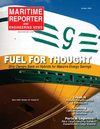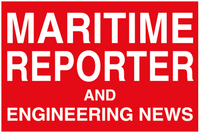
Page 37: of Maritime Reporter Magazine (October 2025)
Read this page in Pdf, Flash or Html5 edition of October 2025 Maritime Reporter Magazine
remained onboard. non-mandatory, it serves as a globally ensuring personnel are trained in proper
An investigation by the Australian recognised standard for the safe packing securing techniques and verifying con-
Transport Safety Bureau (ATSB) re- of shipping containers and other cargo tainer weight and load distribution are vealed that intense rolling and pitching transport units (CTUs). best practices and safeguards against – triggered by gale force winds and a The CTU Code is designed to support cargo damage and loss. temporary loss of propulsion – led to all stakeholders across the intermodal When something goes wrong, insur- the incident. transport chain. It promotes safety, se- ers and marine surveyors will carefully curity, and environmental protection examine how the cargo was packed and
The Role of Proper Packing throughout the cargo journey and is secured. If investigations reveal that ba-
While rough seas and vessel move- widely adopted by industry profession- sic standards were not followed, claims ment are beyond human control, how als and referenced in insurance assess- may be reduced or denied entirely. cargo is packed and secured can make a ments and claims evaluations. At sea, being prepared makes all the critical difference. Following the Code reduces the risk difference. Weather and vessel motion
Many shippers rely on past experi- of damage, improves safety, and helps may be unpredictable, but packing and ence rather than best practice, assuming prevent disputes. According to a 2023 securing cargo is within our control. that if damage has not happened yet, the study by researchers at Italy’s Politec- Proper packing not only prevents dam- method is good enough. However, all nico di Torino , companies that imple- age, but also protects people, cargo, it takes is one instance of extreme mo- mented the CTU Code saw costs and and reputation. tion for that assumption to fail, and with penalties reduced from €670,000 to catastrophic consequences. €13,000, and extra costs as a percentage
Poor practices include, but not limited of revenue cut down from 37% to 10%. to, incorrect weight declarations, espe- cially under-reporting actual container Best Practices weights; improper load distribution Proper packing is one of the most ef- (e.g., heavy cargo on top tiers); inad- fective ways to minimise risk during equate packing inside containers despite marine transit. The people who pack and secure external lashing; and partial or secure the cargo in a container would inadequate securing of upper tiers. probably be the last ones to look inside
These poor practices may lead to the unit till its opening at the destina- damaged cargo, environmental hazards, tion. This, all the people in the supply ? nancial loss, and denied insurance chain including road and or rail trans- claims. port workers, crew members of any in- land or ocean transport vessels, terminal
The CTU Code and Why it Matters operators in ports and others who have
The Code of Practice for Packing of a duty to inspect the cargo and ? nally,
Cargo Transport Units (CTU Code) is those who unpack the unit, rely on the a joint publication by the International securing carried out at the origin. Clear-
Maritime Organization (IMO), the In- ly, poor or insuf? cient practices contin- ternational Labour Organization (ILO), ue to be a leading cause to cargo damage and the United Nations Economic Com- and loss claims.
mission for Europe (UNECE). Although Compliance with the CTU Code and www.marinelink.com 37
MR #10 (34-45).indd 37 MR #10 (34-45).indd 37 10/2/2025 7:13:55 PM10/2/2025 7:13:55 PM

 36
36

 38
38
